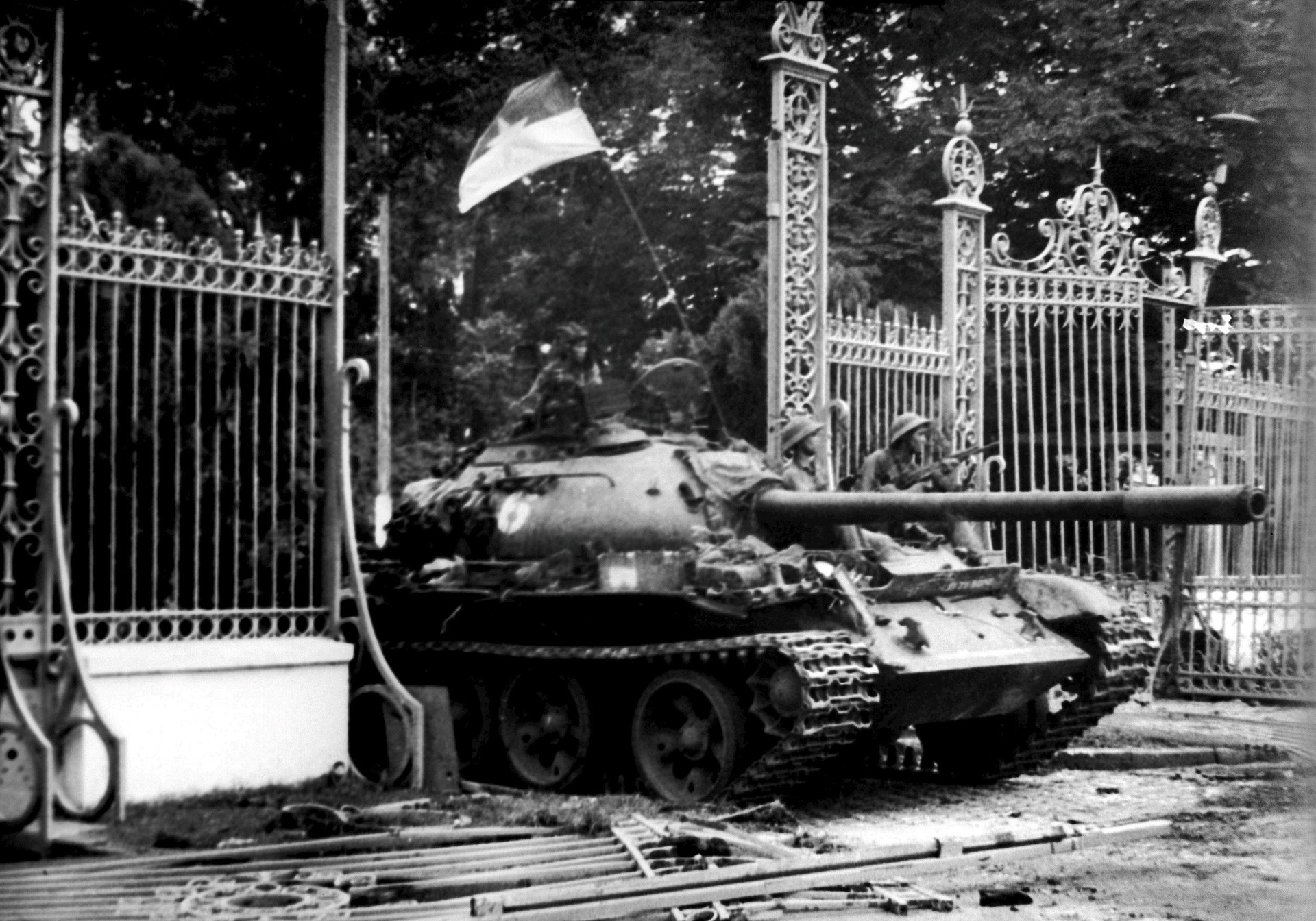This spring, on the threshold of the historic April days, my brother - journalist and writer Tran Mai Hanh - and I made a journey to the old battlefields, along the length of the country. A trip we had wanted to make for a long time...
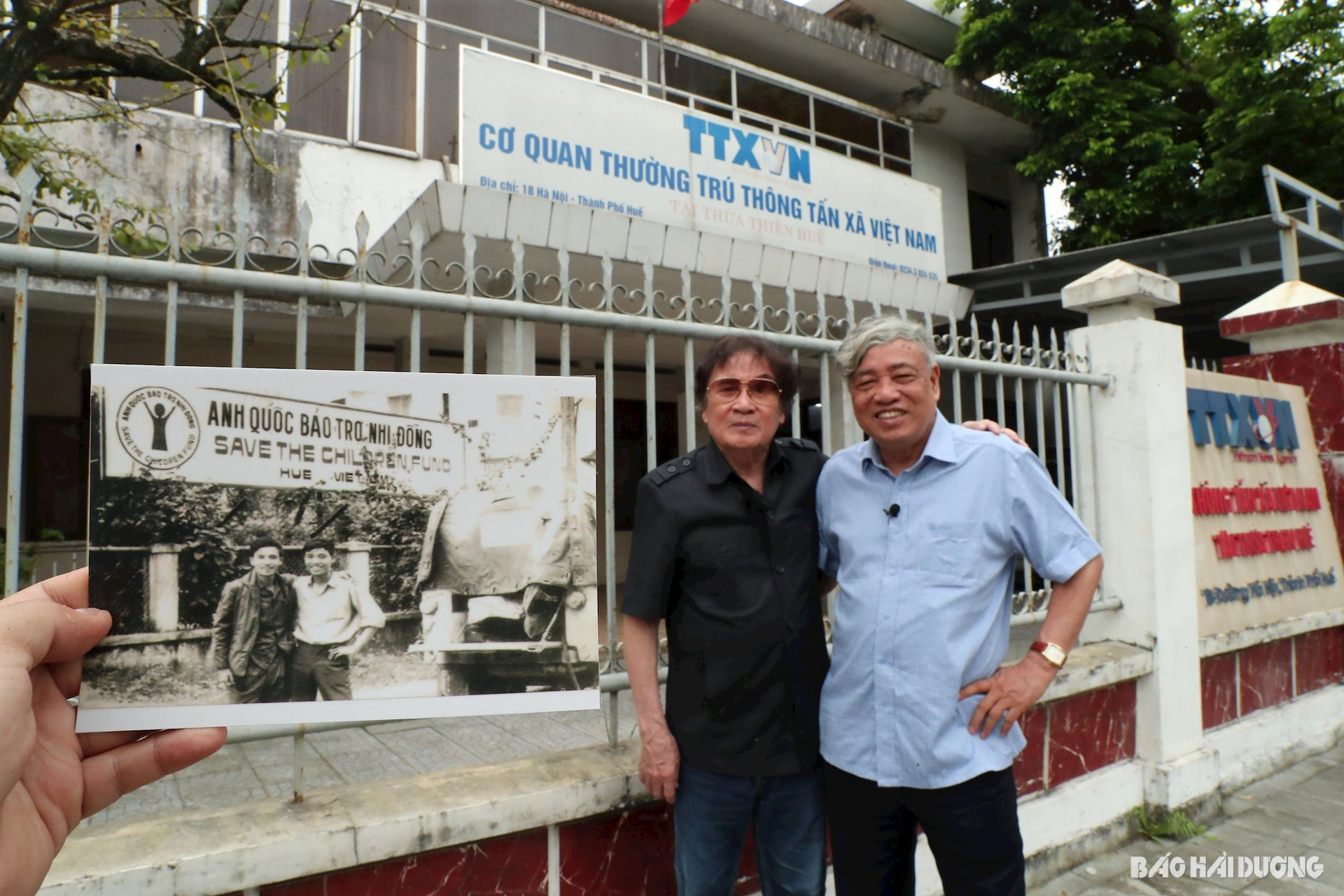
The two brothers crossed the 17th parallel, Hien Luong bridge, Ben Hai river, where the country was divided; through Hue, Da Nang, Quang Nam, Quang Ngai, Quy Nhon - Binh Dinh, Phu Yen; to Nha Trang, Phan Rang, Phan Thiet, through Xuan Loc - Dong Nai to Saigon - Ho Chi Minh City.
A journey back to the distant years, memories of a time of fire and danger and challenges. A journey back to lands and people with many attachments. The affection of friends, colleagues from news agencies and newspapers along the way we passed; the joy of meeting historical witnesses who appeared in our articles and photos from those years. And also new friends with many sincere sympathies... Warm, trusting, affectionate meetings, increasing love for life and inspiring new creative plans.
We crossed the Hien Luong Bridge across the Ben Hai River, where the country was divided for 21 years. For half a century, this land at the 17th parallel had been silent. But the memories of those distant years were still there. In my war diary in early 1972, I wrote when I first arrived here: While waiting for the ferry, I stood on a high promontory looking across the river. What a special feeling. The white belt was silent. Doc Mieu was right in front. Far away was Con Tien on the right, Hill 31 on the left. Further behind was Cua Viet... Road No. 1, the section near the border that had been abandoned for a long time, was overgrown with grass. The road surface was littered with artillery and bomb craters. The border was strangely quiet. Occasionally, I could only hear the sound of artillery starting up somewhere in the light of the flares that were always hovering in the sky. That feeling seemed to deceive normal people. Because underground, in the long stretches of sand along the riverbank, a whole life goes on. That life is waiting for us.
Even though I had prepared in advance, that first day still left a very special impression on me. The female guerrilla in a floppy hat, a scarf around her neck, and the boat seemed to have appeared from a fairy tale. The river surface shimmered in the evening light, reflecting the image of the rickety and lonely Hien Luong bridge in the middle of the river. In the middle of that bridge was a white paint mark. That was the fragile boundary dividing the two parts of our country, and to erase that boundary, millions of people had shed blood.
The landscape of Vinh Linh, Gio Linh, Cam Lo, Dong Ha… has completely changed. New roads, new residential areas are crowded together, it is difficult to find traces of the past. The new Hien Luong Bridge across Ben Hai River is much wider and more beautiful, next to it is still the old bridge, a symbol of a time.
Right on the historic bridge, which still has a white paint stripe that once separated us, we met old acquaintances, including Ms. Hoang Thi Cham, also known as O Cham (according to the regional dialect). Hoang Thi Cham was a famous sniper guerrilla on the McNamara Electronic Belt in the past. She is the person I wrote about in the article "On the Electronic Belt" that has become familiar to readers since those years.
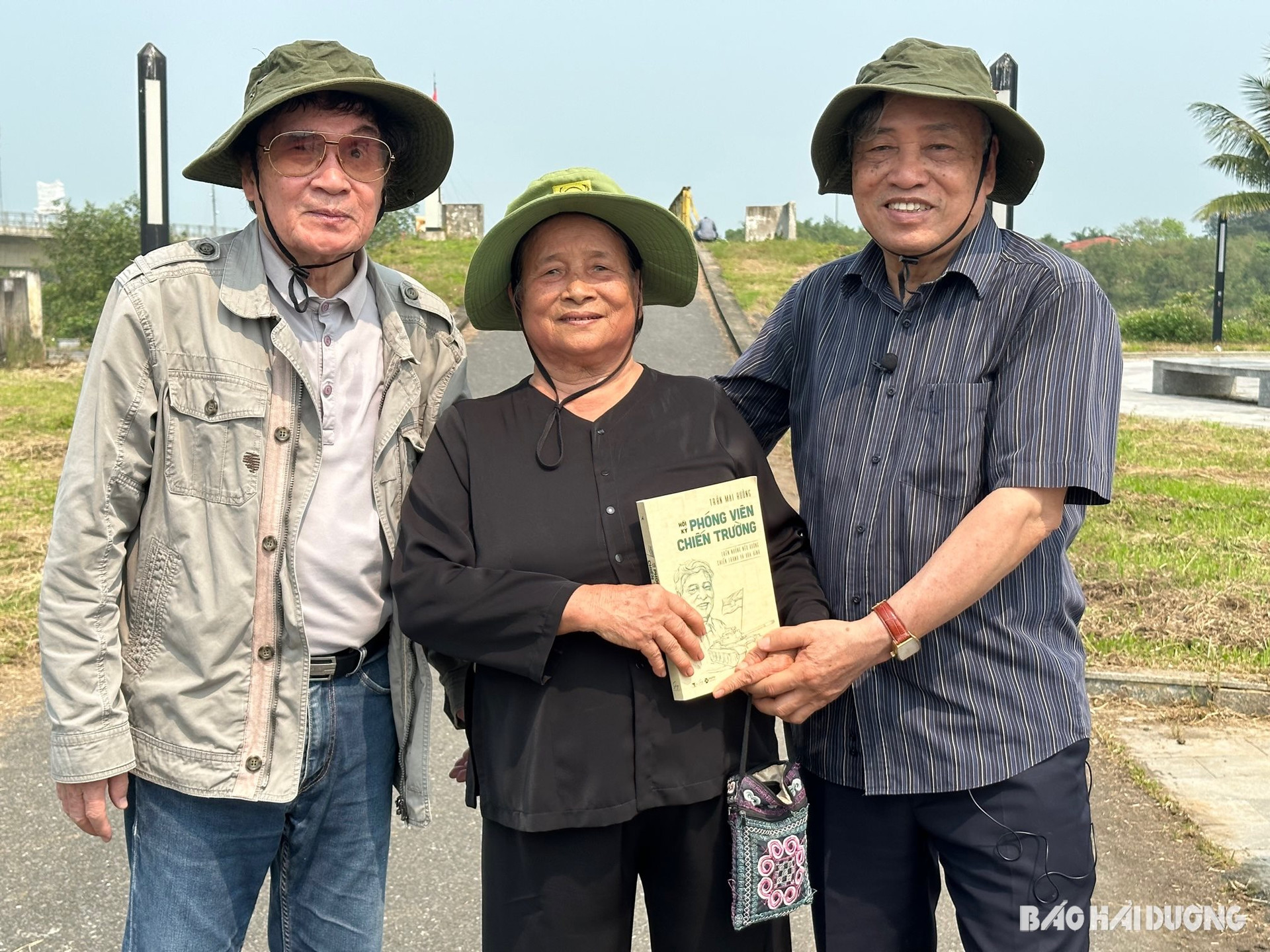
In 1972, after the first phase of the general offensive campaign, I returned to Trung Hai commune (Gio Linh, Quang Tri) to write about the lives of the people here after liberation. I will never forget the image of my sister taking me to visit the belt that day. Smoke from burning fields billowed as the Trung Hai people returned from the concentration camp to their hometowns, preparing for the new rice crop on land still littered with bombs and mines. Right after liberation, a new life began for Ms. Cham’s family and the people in this border area.
After peace, O Cham and her family and neighbors rebuilt their lives in their homeland. She had a happy, peaceful family with many children and grandchildren. In addition to farming, she also became a volunteer midwife, helping to take care of the health of people in the area. Many children were born on this land that was once a place of bombs, death and separation, under the hands of midwife Hoang Thi Cham.
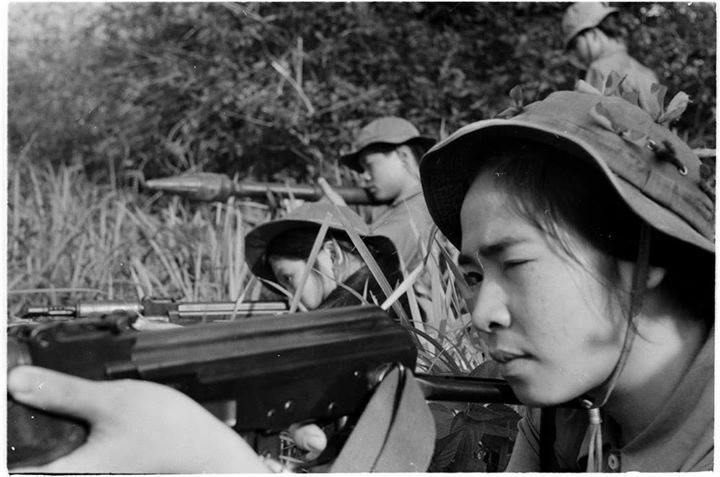
Doc Mieu is where the Gio Linh martyrs' cemetery is located. Together with my colleagues, we had unforgettable moments. This cemetery is the grave of martyr Thu Hong, a guerrilla from Gio My commune, whom I took pictures of before she died in the early days of the campaign. In early 1972, I crossed the border to the South bank for the first time to work. I returned to the team's base not far from Hill 31, right next to the front line, met the guerrillas, listened to their stories about life, took pictures of them training, studying, and living at the base. In some of their pictures, I took a portrait of the female guerrilla, Secretary of the commune union Thu Hong. That picture was later used in the newspaper. Viewers were impressed with the image of the female guerrilla in a shooting position, graceful beauty, soft floppy hat, face shining in the sun. What was extremely painful was that a few weeks later, Thu Hong died on the first day of the campaign, leaving behind an inconsolable grief in everyone's hearts.
.jpg)
This time, when we returned to Doc Mieu cemetery, the officers and soldiers of the Gio My guerrilla team, and Thu Hong's former comrades, were waiting for us. What was special was that when we heard about the trip of Mr. Tran Mai Hanh and I, Ms. Thu Lan, Mr. Duc Trung, Duc Nghia, and Thu Hong's younger brothers from Hanoi, Ho Chi Minh City, and Hue were all present. We visited the grave of martyr Thu Hong and the martyrs in Gio Linh cemetery with deep gratitude and remembrance for those who sacrificed for the independence and freedom of the Fatherland.
I had the opportunity to meet guerrillas from more than 50 years ago. Nguyen Van Em, Tran Xuan Tiep, Nguyen Thi Thiu... Many of them we met for the first time but the feelings were still very sincere and close.
Journalist Tran Mai Hanh and I were in Hue on the day of Hue’s liberation, March 26. Memories returned with unforgettable memories. I remember the night we walked more than 35 km from My Chanh bridge to Hue 49 years ago with journalists Lam Hong Long, Ngoc Qua, Duc Kieu… When we were retreating, the Saigon army was startled and destroyed this bridge so cars could not pass. We walked through the night and arrived in the city at dawn. When I saw Phu Van Lau, Huong River, and Trang Tien Bridge, I thought I was in a dream.
Hue was in the midst of a great festival. The atmosphere was jubilant. The half-red, half-blue flag of the National Liberation Front was flying over Phu Van Lau, over large buildings, and on the streets. Boats and ships were bustling on the Perfume River. Traces of the great retreat of the Saigon army were still everywhere.
I went with photographer Lam Hong Long to the Dong Ba market gate, then got on the Jeep of the students doing propaganda work and drove along the two banks of the river down to An Cuu area, through Vi Da, up to Bach Ho bridge and into the citadel... I sat right on the steps of Phu Van Lau to write the article "Hue's spring morning, red flags fluttering" in the curious eyes of the students that afternoon. The article about Hue was my first in the spring days of 1975. In the article, I tried to capture the atmosphere of the city at that moment: "Hue today is radiant in the early spring sunshine, with the Huong River, Ngu Mountain and the fluttering Ao Dai... But Hue is even more beautiful with the colors of the revolutionary flag and the eyes filled with joy of everyone. The prominent image of Hue on the first day of liberation is still the image of the liberation flag fluttering in front of Ngo Mon gate, the very place where on August 30, 1945, Bao Dai abdicated".
Mr. Tran Mai Hanh and I have a special memory of Hue. On April 4, 1975, the special working group of the Editor-in-Chief of the Vietnam News Agency, Dao Tung, stopped in Hue on the way to the Southern battlefield. Mr. Tran Mai Hanh was a member of the group. The two of us met in Hue. That moment was captured by photographer Van Bao in front of the headquarters of the organization "Britain's Children Sponsorship", which later became the headquarters of the Vietnam News Agency's permanent office in Hue until now. After that brief meeting, we parted ways. The group of Editor-in-Chief Dao Tung, including Mr. Tran Mai Hanh, left Hue first, went through Da Nang, arrived in Quy Nhon, then went up to the Central Highlands, followed the Truong Son road to the Liberation News Agency's base in Tay Ninh. I left Hue later, in the formation of the spearhead reporter team, following the eastern army, going along National Highway 1 to the south. At that time, neither of us could have imagined that just a few weeks later, we would be together at the Independence Palace - Saigon on the historic afternoon of April 30, 1975.
Da Nang today is a modern city, a livable urban area. When walking along the Han River, I remember the city scene on the first day of liberation with many special memories. We entered the city when the US consulate was still burning. Da Nang port was littered with vehicles and weapons. Da Nang airport still had planes that could not take off. The headquarters of the 1st Corps of Lieutenant General Ngo Quang Truong was devastated... I remember the joy and excited faces of the people when welcoming the liberation army. I remember the memory of the motorbike trip with journalists Lam Hong Long, Ngoc Dan, Hoang Thiem from Hue over the dangerous Hai Van pass to be the earliest in this second largest city in the South. From Da Nang at that time, I rode a motorbike alone over the Hai Van pass to bring the films of my team members back to Dong Ha, and at the same time had time to write an article about "Da Nang on the first day of liberation".
In the conclusion of the article signed by Tran Mai - a reporter of the Liberation News Agency at that time, there was a passage: The days of March are entering the history of Da Nang. 10 years ago, on March 23, 1965, the first American soldiers landed on Son Tra peninsula. On March 29, 1973, two years ago, also here, the last American soldiers withdrew from the South.
I remember most the image of the young liberation soldiers in front of Nguyen Tri Phuong barracks, located on Nguyen Truong To street, where the headquarters of the 1st Army Corps of the Saigon army was located, the Army Corps whose Commander, Lieutenant General Ngo Quang Truong, had once declared: "We must keep Da Nang at all costs!" And right when those declarations were being advertised in Saigon newspapers, Ngo Quang Truong abandoned the officers and soldiers and forgot his own orders, jumped onto a ship and fled to sea. The liberation soldier led me to Ngo Quang Truong's office on the second floor, in the right row of houses. The marching map, documents, books, and souvenir photos were scattered on the floor. The 3-star flag (Lieutenant General's flag) was facing the ground and a photo of Ngo Quang Truong was thrown under the table. A young soldier was sitting on an armchair with three stars on a white cloth, the general's rank chair. Ngo Quang Truong's room had many books. I reached for a book on the bookshelf, “Central Floods”. At that moment, I suddenly thought that it was not the Central Floods but the Central Firestorm, the Vietnam Firestorm that had burned down Ngo Quang Truong’s career. And it was also the revolutionary storm that brought dawn to the city, so that a new life in this coastal city could begin.
In Da Nang this time, we had a very special meeting with a Da Nang native. In the article "Da Nang on the first day of liberation", I wrote about her as follows: "Another person returning to Da Nang is Vinh An, a pretty girl from District 1, a former student of Da Nang High School for Girls, who went to the war zone to work. Vinh An returned to her city as a cadre in the city's Propaganda Department. She is one of the happiest people in the city today. Vinh An in a festive outfit, black pants, black shirt, milk-colored coat took journalist Dinh Quang Thanh to take pictures on her family's Honda. Every now and then, Vinh An's car had to stop because she met friends and acquaintances. She said: "It's like a dream, this day has only come after 30 years, guys. I'm living the happiest days!".
Fortunately, journalist Le Pham Tran Quy of Vnews news channel in Da Nang devoted a lot of effort to help me find Vinh An after nearly half a century. The very touching meeting between us - the author of the article and his character - took place at a coffee shop on the day of liberation. After liberation, Vinh An continued to study, graduated, became a university lecturer and had a happy family. Her husband is an official of the Da Nang City Party Committee. Vinh An's very open and friendly meeting and conversation with us like acquaintances after nearly half a century is a beautiful memory of this trip back to Da Nang.
Quy Nhon City is a destination with its own significance on the trip. In April 1975, this was the last city on Highway 1 that Editor-in-Chief Dao Tung's delegation stopped at before continuing on the way to the Central Highlands. Mr. Tran Mai Hanh recalled the delegation's meeting with Binh Dinh leaders at that time, including preparations for the inauguration ceremony of the military management committee and information and propaganda work in the newly liberated city.
In the article "Meeting the Insurgents" when arriving in Quy Nhon, I wrote: Quy Nhon has its own beauty with Ghenh Rang, Mot Mountain and also a large seaport. The city has been liberated for ten days. Life has returned to normal. We passed through busy streets, crowded big markets, churches and pagodas that had reopened. The railway workers along with the city's people rose up, together with the revolutionary armed forces, to take control of Quy Nhon. Many Saigon army units brought their guns back to the revolutionary forces before.
At 5:00 a.m. on April 1, a 13-meter-wide flag of the National Front was raised on the roof of the city hall, announcing the complete liberation of Quy Nhon City. The people of Trung Ai and Trung Kiet wards... occupied the Bach Dang police station. Thousands of people imprisoned in Phu Tai prison, with the help of some Saigon uprising police, liberated themselves. At the station, the train workers rose up to seize guns from the self-armed "civilian guards", then divided themselves to guard each locomotive and train car. The large locomotives were brought to Dieu Tri station, 11 km from the city, and were carefully protected. The machinery warehouse in Ham Da was kept intact. And right after the liberation army returned, the first train also entered the city, pulling dozens of train cars carrying evacuees back. The train flew revolutionary flags, revolutionary slogans, and sounded its whistle loudly to celebrate the city's liberation.
In the midst of today's Quy Nhon with many changes, we returned to the old places in our memories: Dieu Tri Station, the historical memorial site of the first Party organization here; the traditional house of Binh Dinh Electricity, where I went when it was just liberated, when the generators of Quy Nhon Power Plant were located... We had a very touching meeting with Mr. Nguyen Duy Quy, former Secretary of Binh Dinh Provincial Party Committee. Mr. Quy was the Political Commissar of Regiment 72, the unit that participated in the liberation of Quy Nhon at that time. The story with the veteran revolutionary, who devoted his whole life to the fight for independence, freedom and building a new life on this land, left many special impressions on us.
In Nha Trang, we visited the Pasteur Institute, the Institute of Oceanography, Dam Market… places that were imprinted in my memory at that time. We also revisited the Nha Trang City Party Committee’s base in the early days of the takeover. That was also where our spearhead reporter team stayed, with the help of the City Party Committee and the people of Nha Trang, to repair the radio, contact the General Office in Hanoi, and broadcast news articles, including articles about life in the early days of liberation in Quy Nhon and Nha Trang.
At that time, also from Nha Trang, we arrived in Phan Rang in time, when this "steel shield" was smashed. In the article "Entering Phan Rang for liberation", I wrote: Along the way, traces of major battles still remained, the remains of military vehicles and tanks were still burning. At Thanh Son airport, a C130 nose-dived on the runway because it had been hit by bullets before it could take off. The airport was littered with personal weapons, vehicles, military uniforms... We walked along Thong Nhat Avenue to the Provincial Governor's Palace, which at that time was the workplace of the Military Management Committee... A very large picture of President Ho Chi Minh hung in the nearby information center. Many people were standing and watching. An elderly man told me: It's been more than 30 years since I saw Uncle Ho's picture!
.jpg)
We know that the painters had to work hard all night to complete this large painting. Standing guard in front of the center was a tall, thin girl, wearing a soft floppy hat, a dark brown outfit, and a very gentle face. When asked, we learned that her name was Tran Thi Son. Three years ago, Tran Thi Son was a poor seamstress, living at number 10 Le Loi Street, participating in the activities. Today, Son returned to her hometown in the joy and emotion of her friends, relatives and neighbors. Tran Thi Son told us: I met acquaintances and friends again. Everyone was surprised. For me, the moment my homeland was liberated, the moment we met was so sudden. Everyone believed that one day, but I didn't expect it to be today...
That article also has a special memory for me: The very next morning in Phan Rang, I went back to Nha Trang by motorbike alone. The road was new, hundreds of kilometers, and traveling alone in a newly liberated area was quite dangerous. In addition to the pistol, I also brought a carbine with a folding stock that I got at Thanh Son airport. When I arrived in Nha Trang, that very afternoon, I sat down to write an article about Phan Rang to send back with the situation report of my team members to Hanoi.
Returning to Phan Rang - Thap Cham these spring days, we visited the city, returned to the places I had been to, visited the famous Po Klong-Garai Cham tower, Phan Rang market, the provincial administrative building, now the headquarters of the Ninh Thuan Provincial Party Committee... The most special thing here was that I met again the female self-defense fighter Tran Thi Son that I wrote about in the article "Entering Phan Rang for liberation". Female self-defense fighter Tran Thi Son has participated in many activities since her homeland was liberated, later becoming the President of the Provincial Women's Union, then Director of the Department of Internal Affairs. We met Tran Thi Son again after 49 years as close sisters. She was very touched when I gave her the article about Phan Rang that mentioned her image. She said very sincerely: I could not have imagined that I would meet the reporter from the past, with such a special gift, I could not have imagined that my life would be so lucky and happy!
We returned to Phan Thiet and were very happy to meet our colleagues at the Vietnam News Agency. Naturally, we talked a lot about the journalist and photographer Lam Hong Long, who had passed away. He was a great photography talent and was awarded the Ho Chi Minh Prize for his works "Uncle Ho catches up with the Union" and "Mother and son on the day of meeting". He was also a son of his hometown Phan Thiet. There is a street named after Lam Hong Long in this city.
Memories of half a century ago came back to me. In March 1975, I had the opportunity to go to Hue and Da Nang with photographer Lam Hong Long. After that, we were together in the spearhead reporter team of the Vietnam News Agency, marching in the rapid footsteps of the eastern army, traveling along the southern part of the country, through a series of cities, witnessing many battles to be present at the Independence Palace on the historic afternoon of April 30, 1975. Around mid-April, I went with Lam Hong Long through Phan Rang - Thap Cham, to Phan Thiet. I was a newcomer here, and he was the one returning to his homeland after 21 years away. I will never forget his emotional face, the stories he told when we rode together on a Honda on this road. I visited Duc Thanh school with him, where Uncle Ho used to teach, met with the people of Phan Thiet, took pictures of boats with the liberation flag going up and down the Ca Ty river... Our brothers in the spearhead group witnessed the moment Lam Hong Long met his blood relatives after many years apart. At that time, his family was living in La Gi town - Ham Tan, not far from Phan Thiet.
In 2002, Binh Thuan province named a street after Lam Hong Long, 5 years after the famous photographer passed away. We also went to Ham Tan-La Gi, visiting the house that has now become a place of worship for the photographer Lam Hong Long's family. In La Gi, there is also a street named after Lam Hong Long.
.jpg)
We returned to Dong Nai on an April afternoon. Together with my colleagues, we visited the places associated with the last days of the war: the old Xuan Loc town (now Long Thanh city), where an important battle took place, destroying the last shield of the Saigon army in the east, where the Vietnam News Agency reporter team met the 304th Division (the twinned Vinh Quang Division) as if by chance at the right time when the historical opportunity was coming. We revisited the Ong Que rubber plantation, now Ong Que Farm, where we had our last radio sessions with Hanoi at important moments of the war; the area of the Nuoc Trong armored school, where I was with the 2nd Corps Command during a very fierce battle before following the eastern army's deep thrust into the center of Saigon...
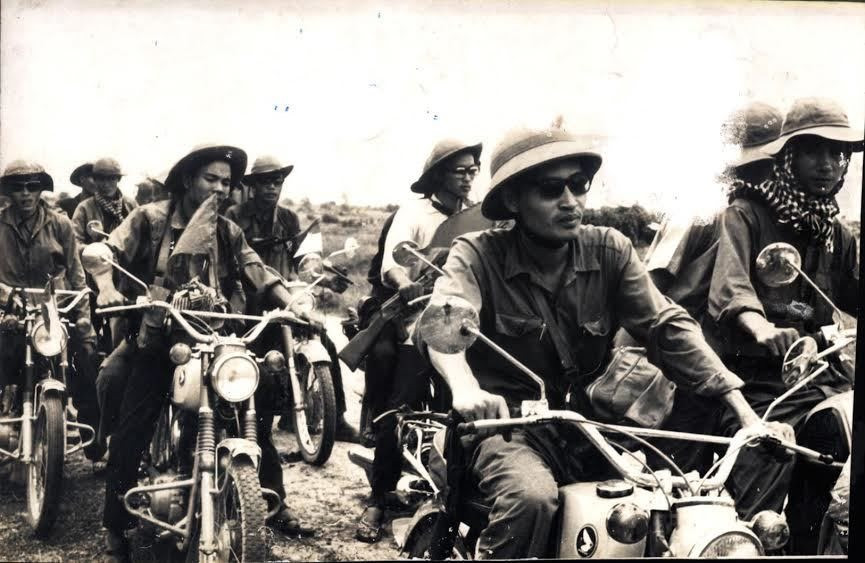
From Nuoc Trong base, journalist Tran Mai Hanh and I crossed the Buong River, crossed the Dong Nai Bridge along the highway into the city, following the same path that the eastern army had taken on the morning of April 30, 1975. On the way, Tran Mai Hanh and I shared with our colleagues memories of that unforgettable moment. I followed the spearhead reporter team, along with Vu Tao, Dinh Quang Thanh, Hua Kiem... into the city from the east. Tran Mai Hanh, photographer Van Bao, reporters from the Liberation News Agency, and the liberation army entered the city from the west. Being present at the Independence Palace at noon on April 30, 1975 with our colleagues on the day of total victory was the most wonderful memory in our lives as war reporters. Fortunately, we all contributed to the contributions of the whole team: Journalist Tran Mai Hanh wrote the first report "Ho Chi Minh City shines with golden stars"; The ideas formed from that historical moment later helped him write "War Record 1-2-3-4.75", a work that was awarded the highest prize of the Vietnam Writers Association and the ASEAN Literature Award. I captured the image of "Liberation Army tanks entering the Independence Palace at noon on April 30, 1975", a work that was widely used as a symbol of the historic Great Victory of Spring 1975.
